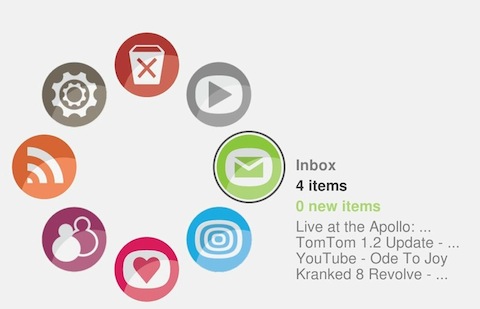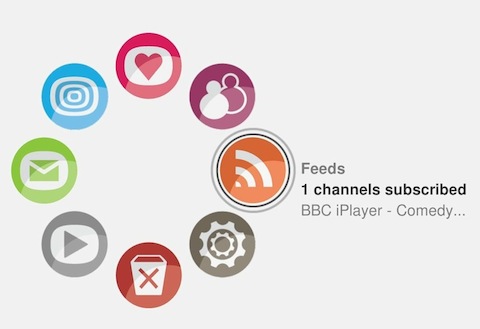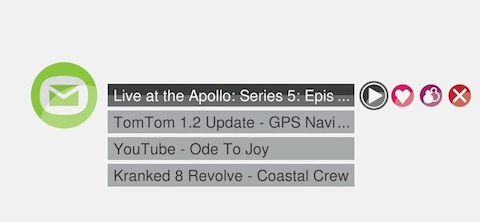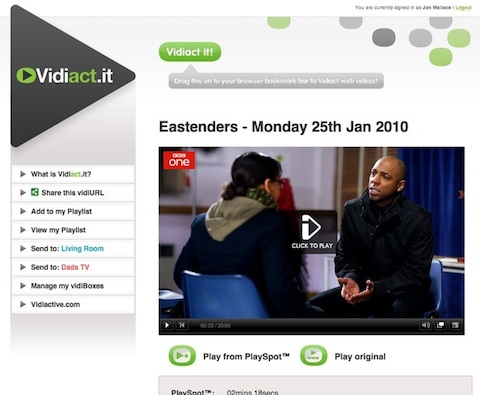Original URL: https://www.theregister.com/2010/07/19/vidiactive/
YouTube, iPlayer on a TV? Simples
You don't need a mega set top box...
Posted in Software, 19th July 2010 10:09 GMT
Simple solutions usually beat over-engineered ones, and a UK software startup I've met might have solved a couple of the biggest headaches of watching web video. I came away from the demo wondering why people hadn't thought of doing this before.
Currently, there's a problem getting the vast amounts of web content out there - on sites such as YouTube, iPlayer or Hulu - so you can watch it in comfort on your sofa. The various industries have tried to address this in a few different ways. There are huge engineering projects that chuck the kitchen sink into the set-top box - Google TV or the BBC-led Canvas. Or there are walled gardens, that hand-pick a tiny selection of web material the manufacturer deems safe: Panasonic's Viera Cast, for example. Many of us have hooked up a home PC or Mac to the TV, which means wrestling with something like Windows Media Centre, Apple's FrontRow or Myth TV - but these still allow you to watch YouTube as a "sit-back" experience.

The "home" screen
Vidiactive's software puts YouTube and iPlayer on your living room TV so you don't have to fiddle around with a laptop. It also allows you to discover web video, unobtrusively, for watching on the big screen. It may still be a bit unpolished (it's version 1.0) but it already does 90 per cent of what people want, using web standards that are already out there, and content that's already out there too.
The company is a small start-up staffed by experienced British techies, and the is software designed to be embedded in other people's set-top boxes, or TVs, or a very low cost dedicated box. Vidiactive has an ARM-based reference box, but the demo I saw was on an Atom laptop. Broadband operators also might be interested in bundling a cheap box with broadband contracts, the company hopes.
CEO Ben Hookway, says that the two industries converging both bring strange assumptions when they design products.
"The TV world doesn't get the difference between a shared screen such as a TV and a personal screen such as your laptop. They want to put Twitter on the TV screen, or put email on the TV screen - but what you do on a personal screen is different to what you want on a TV."
For their part the broadcasters are obsessed with control, and have no desire to make it easy for us to hop out of the walled garden to watch (say) Drum and Bass Church Rave. Why would they? Even Canvas, which on paper started out with very similar simple goals before succumbing to platform-itis, is now an old-school tussle between media giants over EPG placement, and which relegates YouTube to a sub-submenu.
It's probably best illustrated by this rough 1.x software - a slicker UI is underway - but this illustrates the simplicity of the approach.
Populate your playlist using auto-discovery, searching on keywords for specific programs. For example, "BBC drama" has an RSS feed that will find the content on iPlayer.

Auto-discovery via RSS

Series stacking made simple

Control the video by remote - without opening a laptop

'Set up and forget' subscriptions via a web portal
All this was accomplished with a small team working for a year. It uses the open source webkit for a browser, CTO Ken Tindell told us. The overlays are done in OpenGL.
Advertisers like it because it adds a new audience - it doesn't interfere with the ads in any way.
"No one's going to throw away their FreeView box," the company reckons, but it's much easier than bridging the PC to TV gap to watch web video. He predicts, as others do, an epic "battle of the platforms" - but each will have to address what Vidiactive has tried to solve.
"In five to seven years we'll subscribe to services on the basis that I'm a Google guy, or I'm a Canvas guy, or an I'm Apple or Microsoft guy."
It seems pretty obvious. Getting this simple solution out into the marketplace is likely to be down to telcos, who so far have been burned by IPTV.
"Nobody wants to do a BT Vision, spend billions, and get 500,000 subscribers," he says.
But you don't need to spend billions, as Vidiactive nicely demonstrates.
I was also struck by the fact that TV's dinosaurs, obsessed with control, and the TV-is-dead crowd of utopian web nutters both really missed the point. Web video won't kill TV, provided TV can continue to produce quality high-value TV. It certainly won't kill anything, given the current economics of moving bits around via IP, except perhaps ISPs. It's a nice bolt-on, though - and the reason we haven't been using it is because vested interests don't want to make it easy for us. ®